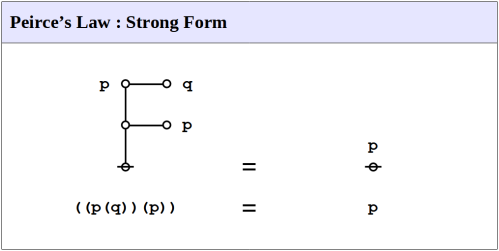Equational Form
A stronger form of Peirce’s law also holds, in which the final implication is observed to be reversible, resulting in the following equivalence.
The converse implication is clear enough on general principles, since
holds for any proposition
Representing propositions as logical graphs under the existential interpretation, the strong form of Peirce’s law is expressed by the following equation.
Reference
- Peirce, Charles Sanders (1885), “On the Algebra of Logic : A Contribution to the Philosophy of Notation”, American Journal of Mathematics 7 (1885), 180–202. Reprinted (CP 3.359–403), (CE 5, 162–190).
Resources
- Logical Graphs • Peirce’s Law
- Logical Graphs • First Impressions
- Logical Graphs • Formal Development
- Metamath Proof Explorer • Peirce’s Axiom
- Propositional Equation Reasoning Systems
cc: FB | Logical Graphs • Laws of Form • Mathstodon • Academia.edu
cc: Conceptual Graphs • Cybernetics • Structural Modeling • Systems Science


Pingback: Survey of Animated Logical Graphs • 6 | Inquiry Into Inquiry
Pingback: Logical Graphs • Interpretive Duality 3 | Inquiry Into Inquiry
Pingback: Logical Graphs • Interpretive Duality 4 | Inquiry Into Inquiry
Pingback: Survey of Animated Logical Graphs • 7 | Inquiry Into Inquiry
Pingback: Interpretive Duality in Logical Graphs • 3 | Inquiry Into Inquiry
Pingback: Logical Graphs • Formal Development 8 | Inquiry Into Inquiry
Pingback: Survey of Animated Logical Graphs • 7 | Inquiry Into Inquiry
Pingback: Survey of Animated Logical Graphs • 8 | Inquiry Into Inquiry
Pingback: Survey of Animated Logical Graphs • 8 | Systems Community of Inquiry